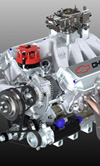Low oil pressure, sir?
 Rather like the blood circulating around our bodies, the lubricating oil in an engine is fairly critical to its well being. For most of the time we don't give it a second thought but it is only when things go wrong that people start paying attention. And for most of these the first thing they will notice is a reduction in oil pressure.
Rather like the blood circulating around our bodies, the lubricating oil in an engine is fairly critical to its well being. For most of the time we don't give it a second thought but it is only when things go wrong that people start paying attention. And for most of these the first thing they will notice is a reduction in oil pressure.
Low or no oil pressure at all is a common enough problem and while the obvious (to some) culprit might be the oil pump, in 999 cases out of 1000 this does not turn out to be the case. Their logic is simple. No oil pressure - it must therefore be the pump. But in reality there are 1001 other, more likely causes. At this juncture, it is well worth remembering that an oil pump is designed to produce flow. The resistance to flow as a result of restrictions in the oil galleries, bearings and journals introduces the pressure element in the equation and therefore should anything change in these there will be a corresponding change in the oil pressure. Replacing the oil pump on such occasions is therefore most unlikely to resolve the issue.
Funnily enough, the most common reason for low oil pressure is simply lack of oil. Although the theory on oil volatility with modern 'synthetic' oils would tend to suggest otherwise, in practice many of these 'thinner', less viscous oils do seem to require more frequent top up than older products. Whether this really is the case or not is difficult to ascertain, but the stark fact is that vehicle manufacturers tend to have more warranty claims put down to low oil levels (in other words high oil consumptions) than ever before. This may of course have something to do with owners being less likely to check their oil levels on a frequent basis but whatever the cause, the result is still the same.
Another cause of no oil pressure, as silly as it may sound, is actually a faulty gauge or sender unit. In competition cars, gauges, whether they are mechanical or electrical have a hard time of it. High underbonnet temperatures and rigidly or stiffly mounted engines create the most difficult of regimes in which excessive vibration transmitted through to the chassis or the shock loading experienced by an off-road event will almost certainly cause any electrical or mechanical gauge to fail in time. I once measured the 'G' loadings on an electrical component mounted off the side of the cylinder block of a 4 cylinder engine mounted somewhat rigidly in an engine dynamometer cell. At resonance, the accelerations measured were in the region of 25-30 times that due to gravity, which proves if proof were ever needed, the hostile conditions under which many of these components are expected to live.
Blocked filters and loose or partially restricted oil pick up pipes are another less obvious cause but the funniest if not a slightly scary one, is that of the wrong dipstick. As an engine manufacturer you would never believe the trouble that this seemingly simple yet highly practical approach to measuring the oil level can cause. Most engine manufacturers will have different engine derivatives according to the intended vehicle in which it is to be installed. In many cases with different levels of 'dress', that is positioning of things like power steering pumps, generators and air conditioning pumps, the position of the dipstick will need to change for reasons of access. Different positions of the dipstick require different lengths and while this can be readily controlled during manufacture, in the service workshop practices may not always be that robust. You can therefore appreciate that after changing the oil and replacing the correct volume of oil for that car, having temporarily misplaced the dipstick another was found to 'plug' the hole. Slightly longer and calibrated for a different dress of engine, the red oil warning light came on long before oil level reached the minimum point - on the dipstick.
If ever there was a moral to these stories it is this. If you should ever be in the position of experiencing low or heaven forbid, no oil pressure, check the simple things first before pointing the finger at the oil pump.
But better still, check your oil regularly whether race or road.
Fig. 1 - Perhaps the most critical part of many oil systems - the dipstick.
Written by John Coxon